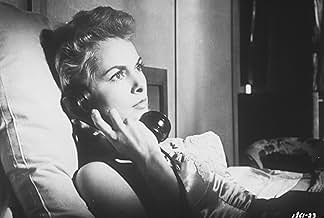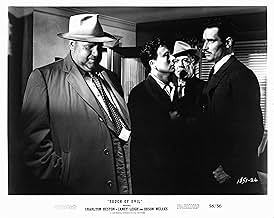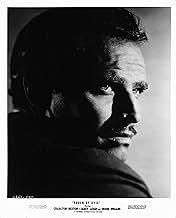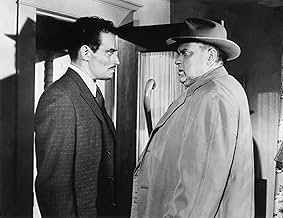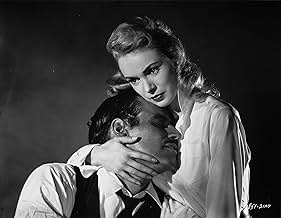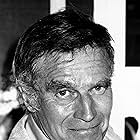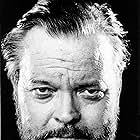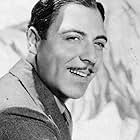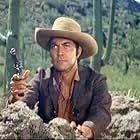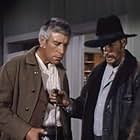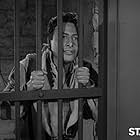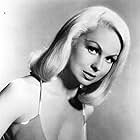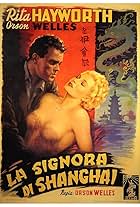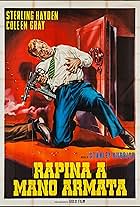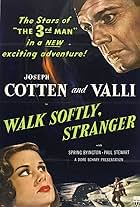Una storia cruda e perversa di omicidi, rapimenti e corruzione in una città al confine messicano.Una storia cruda e perversa di omicidi, rapimenti e corruzione in una città al confine messicano.Una storia cruda e perversa di omicidi, rapimenti e corruzione in una città al confine messicano.
- Premi
- 7 vittorie e 1 candidatura
Valentin de Vargas
- Pancho
- (as Valentin De Vargas)
Trama
Lo sapevi?
- QuizJanet Leigh's agent initially rejected her participation in this film due to the low salary offered without even consulting the actress. Orson Welles, anticipating this, sent a personal letter to the actress, telling her how much he looked forward to their working together. Leigh, furious, confronted her agent telling him that getting directed by Welles was more important than any paycheck.
- BlooperThe car that blows up four minutes into the film has the Texas plate AG 3724; 32 minutes into the film, police car number 10 also has the Texas plate AG 3724.
- Curiosità sui creditiOpening statement (restored version): In 1957, Orson Welles completed principal photography on TOUCH OF EVIL and edited the first cut. Upon screening the film, the Studio felt it could be improved, shot additional scenes and re-edited it. Welles viewed this new version and within hours wrote a passionate 58-page memo requesting editorial changes. This version represents an attempt to honor those requests and make TOUCH OF EVIL the film Orson Welles envisioned it to be. "... I close this memo with a very earnest plea that you consent to this brief visual pattern to which I gave so many long hard days of work." -- Orson Welles
- Versioni alternativeA new version, running 111 minutes, has been restored by Universal and debuted at the Telluride Film Festival in September 1998. This version has been re-edited according to Orson Welles' original vision, as outlined in a 58-page memo that the director wrote to Universal studio head Edward Muhl in 1957, after Muhl took editing out of Welles' hands. The new version has been prepared by editor by Walter Murch, sound recordists Bill Varney, Peter Reale and Murch, and picture restorer Bob O'Neil under the supervision of Rick Schmidlin and film critic Jonathan Rosenbaum. One difference between the two versions is that the famous opening tracking shot is now devoid of credits and Henry Mancini's music, featuring only sound effects.
- ConnessioniEdited into American Cinema: Film Noir (1995)
- Colonne sonoreMain Title (Touch of Evil)
Written by Henry Mancini
Performed by United International Orchestra;
Rolly Bundock (bass); Shelly Manne (drums); Barney Kessel (guitar); Jack Costanzo, Mike Pacheco (percussion); Ray Sherman (piano); Dave Pell (baritone sax); Plas Johnson (tenor sax)Conrad Gozzo, Pete Candoli, Ray Linn (trumpets) ;Red Norvo (vibes)
Recensione in evidenza
Seldom have I seen so many comments with so little understanding. The movie is not about Heston's "Mexican-ness" or lack of it. The movie is not about the 5 or 8 or 10 minute opening shot. The movie is not even, god help us, about Welles' descent from the heights into "slumming it" in a "Grade B" flick.
The movie is about two things : film-making, and character. Every shot worth remembering (and there are few that aren't) is an exercise in the possibilities of film, particularly black and white film. Woody Allen makes movies in black and white that are all conversation. Welles made movies in black and white because that's where the colors of the characters, the location and ultimately the meaning of the movie are possible. Black and white film is about the infinite possibilities of shadow. Touch of Evil is about the infinite possibilities of human nature.
Heston, for those of you who just can't see past a "bad" accent is about rigidity and short-sightedness. What kind of idiot would leave his wife in all those threatening situations? The kind of idiot who can't imagine that anyone would harm HIS wife, simply because she IS his wife! Akim Tamiroff's Grandi is about flexibility to the point of breakage. Always playing ALL ends against the middle he is the essence of "harmless" corruption, that ultimately harms everyone.
And Welles' Hank Quinlan ... I just don't have the time or space to explain that Quinlan is about the true cost of police work when the humanity has gone out of it. Ultimately Quinlan would kill his best and only friend, the only one, as Dietrich has it, who really loves him. At one time, perhaps, Quinlan WAS the image that Pete Menzies saw. But the man behind that image was eaten up long ago with alcohol and frustrated grief. It's all about winning and losing now, and things he would never do. Until he does them.
There are so many other moments and characters that I'm afraid you'll just have to watch the film with your eyes and your mind open instead of shut to "get it". Pay attention to what's on the screen instead of the smart, cynical, hip comments you can make about an actual work of heart.
Well, what the hell. Joan Didion said it best. Film criticism is petit point on kleenex.
Raoul Duke
The movie is about two things : film-making, and character. Every shot worth remembering (and there are few that aren't) is an exercise in the possibilities of film, particularly black and white film. Woody Allen makes movies in black and white that are all conversation. Welles made movies in black and white because that's where the colors of the characters, the location and ultimately the meaning of the movie are possible. Black and white film is about the infinite possibilities of shadow. Touch of Evil is about the infinite possibilities of human nature.
Heston, for those of you who just can't see past a "bad" accent is about rigidity and short-sightedness. What kind of idiot would leave his wife in all those threatening situations? The kind of idiot who can't imagine that anyone would harm HIS wife, simply because she IS his wife! Akim Tamiroff's Grandi is about flexibility to the point of breakage. Always playing ALL ends against the middle he is the essence of "harmless" corruption, that ultimately harms everyone.
And Welles' Hank Quinlan ... I just don't have the time or space to explain that Quinlan is about the true cost of police work when the humanity has gone out of it. Ultimately Quinlan would kill his best and only friend, the only one, as Dietrich has it, who really loves him. At one time, perhaps, Quinlan WAS the image that Pete Menzies saw. But the man behind that image was eaten up long ago with alcohol and frustrated grief. It's all about winning and losing now, and things he would never do. Until he does them.
There are so many other moments and characters that I'm afraid you'll just have to watch the film with your eyes and your mind open instead of shut to "get it". Pay attention to what's on the screen instead of the smart, cynical, hip comments you can make about an actual work of heart.
Well, what the hell. Joan Didion said it best. Film criticism is petit point on kleenex.
Raoul Duke
I più visti
Accedi per valutare e creare un elenco di titoli salvati per ottenere consigli personalizzati
Dettagli
- Data di uscita
- Paese di origine
- Lingue
- Celebre anche come
- Touch of Evil
- Luoghi delle riprese
- El Rancho Courson Motel, SW corner of E Barrel Springs Rd and Courson Ranch Road, Palmdale, California, Stati Uniti(Mirador Motel - now site of a residential cul-de-sac)
- Azienda produttrice
- Vedi altri crediti dell’azienda su IMDbPro
Botteghino
- Budget
- 829.000 USD (previsto)
- Lordo Stati Uniti e Canada
- 2.247.465 USD
- Fine settimana di apertura Stati Uniti e Canada
- 70.725 USD
- 13 set 1998
- Lordo in tutto il mondo
- 2.285.063 USD
- Tempo di esecuzione1 ora 35 minuti
- Colore
Contribuisci a questa pagina
Suggerisci una modifica o aggiungi i contenuti mancanti

Divario superiore
By what name was L'infernale Quinlan (1958) officially released in India in Hindi?
Rispondi




